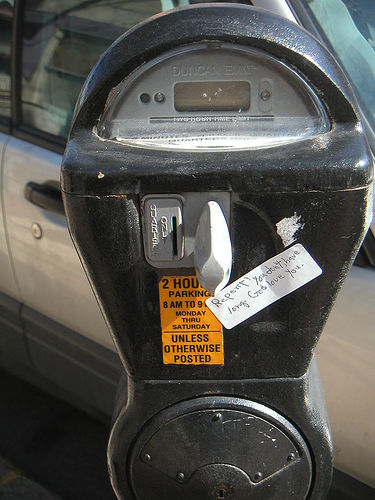Series Examines Paradigm Shift in Public Parking Requirements
 Flickr photo by Crowbert (Chicago).
Flickr photo by Crowbert (Chicago).After decades of parking requirements that mandated free and abundant parking, some planners are questioning the status quo. A three-part series on Planetizen, the public-interest planning and development website, explores the benefits of more efficient parking strategies.
The second piece, The Price Of Parking On Great Streets, comes from the speech by Donald Shoup, UCLA professor and author of the recent book The High Cost of Free Parking, made at DC's "Great Streets" conference in late January.
One of Shoup's major points is to get the local commercial (or residential) district on the same page with parking management, by directing the net revenues after collection and administration to public space improvements in the neighborhood. (This is discussed at length in The Price Of Parking On Great Streets.)
Mott Smith suggests, in Onsite Parking: The Scourge of America's Commercial Districts:
Provide Parking, But As a Community
So, if parking is a necessary evil, it should be provided by the community rather than by individual owners, on a site-by-site basis. This can be accomplished using on-street spaces (metered or not), public lots, public garages, and/or public valet services to increase capacity.
When retail parking must be provided onsite, owners have a strong incentive to "trap" visitors in their stores' lot and discourage them from traveling anywhere elsewhere on foot. (If they didn't discourage walking to other properties, their parking could potentially be filled by people shopping at competitors’ establishments.) The result is that shops are designed to be inward-looking, and opportunities to encourage pedestrian activity are quashed.
But when parking is public, the incentives are flipped. All customers arrive on foot, so retailers do best by building stores that are attractive and accessible to pedestrians.
And in Parking Management: Innovative Solutions To Vehicle Parking Problems; Tod Litman of the Victoria (BC) Transport Policy Institute provides food for thought on the parking dilemma:
Parking management includes various policies and programs that result in more efficient use of parking resources. It means, for example, that a parking facility serves multiple destinations, that the most convenient spaces are managed to favor priority uses (such as deliveries and quick errands), and that motorists can easily obtain information on parking location and price. This squeezes more value from each parking space and reduces the amount of parking needed to serve an area.
Conventional parking planning tends to focus primarily on quantity. It assumes that, when it comes to parking, more is always better, and there can never be too much...
Also, Chris Caldwell pointed me to this story in the Chicagoist, "Proposal Cracks Down on Free Parking Vultures," but Chicago is a much more automobile-centric town than DC. It's colder for one thing...
 Capitol Hill, A Street SE, Washington, DC.
Capitol Hill, A Street SE, Washington, DC.Index Keywords: parking



0 Comments:
Post a Comment
<< Home